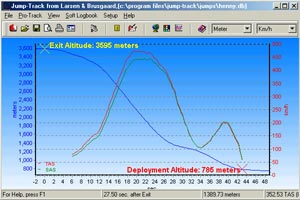 |
Speedskydiving |
Most skydivers always feel the need to push the limits and find the edge of their abilities. One of these limits is the fallrate, the speed a person can reach during freefall. The ultimate thrill!? For this their are two ways. One within the Troposphere (0 - 10 km) and one within the Stratosphere (10 - 50 km). On this page I would like to focus on the speed from our "standard" skydiving altitudes (4km) but will short explain the other way.
In the late fifties and early sixties several civilian and military test jumpers tried to break the high altitude record. Those jumps were mainly made from weather balloons. Because of the very high altitudes and therefore extreme circumstances, very low temperatures of minus 60° C and no oxygen, many pioneers didn't survive and died a horrible death. One person that did succeed was Joe Kittinger who's still record holder of the highest jump (103.000 ft. = 30 km). He made a couple of jumps in a program to check the possibilities of survival if bailing out of the Apollo in the Stratosphere. Because he used a drogue parachute to break his speed and keep stability during freefall the record for the highest speed is not recognized by the FAI.
Now 40 years later this record is still not broken but there are two persons trying to beat it. The first is Michel Fournier from France and very recently Cheryl Stearns announced to prepare serious attempts with the help of the American Airforce. Because of the almost ultimate thin air the highest speeds can be reached here. Not only the altitude record will be broken but also the sound barrier will be broken.
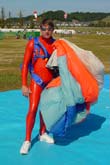 |
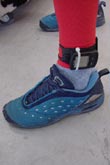 |
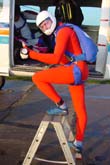 |
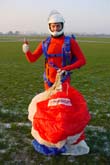 |
For us "regular" skydivers we have to stay within the Troposphere and because of the costs even from the standard altitudes. Past two years a French skydiver (Mike Brooke) developed competition rules for a new discipline named "Speedskydiving". He made a special website www.speedskydiving.net just about this subject. In short you exit from about 4 km, go into a complete headdown dive, go as fast as possible and break your speed before deploying your parachute. The speed is measured with two ProTracks (from Larsen & Brusgaard from Denmark) worn on your ankles between a fixed altitude.
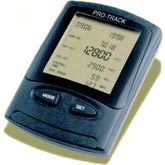 |
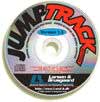 |
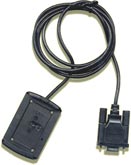 |
Two seasons ago this was also a new challenge for me again too, so I made a couple of jumps with the tightest suit I had but noticed that I couldn't break the 400 km/h speed barrier. I really liked it so I finally bought a special latex (slick) speedsuit made by a French company Jonathan & Fletcher. They also make the suits for speedskiing. With this suit I was able to go much faster and soon got 456 km/h.
On my dropzone I was the only one for a while and persuaded my colleague cameraman Martijn van Dam to join me. He could use a lot of my experience (including my suit) and had a very fast progress. He was soon faster than me (473 km/h) but we're both still not on our limit. The maximum speed on competitions at this moment is around 500 km/h.
Research!
During all the attempts we did we started to doubt about our equipment. Would we go faster if we could streamline it more. As Dutchmen we new from our National top iceskaters that the fabric was very important to have the lowest drag. They probably have the best results with their 50 km/h. so we were wondering if this fabric would work with our speeds of 500 km/h. as well? The only way to find out was testing it. On the same moment Jette Jonkers walked in on our DZ and had the same ideas. Because she's studying Management and Design on the Institute for Fashion (Montaigne Amsterdam) it would be a real challenge for her too to find out how to improve our clothing. She got in contact with several suppliers of fabrics and ended up with good response from Raps here in the Netherlands, only 40 km away from our DZ. Raps is a small company specialized in Ice-skating equipment like clothing and skates itself. By here we were able to get a demo suit with which we could test. Raps tested the suit with skaters in a windtunnel and got good results compared to the fabric in use now.
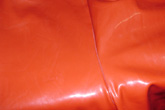 |
 |
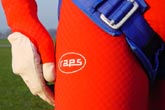 |
The fabric we got was not smooth like my latex "condom" but just the opposite. It has a structure like a golfbal. The idea is that this creates a small layer of air over the surface which has the effect like a hovercraft on water.
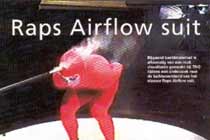 |
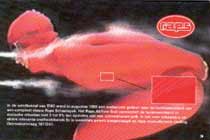 |
So I made a few jumps with this suit. Already short after the exit I felt that this suit flies very different, much more control (easier to keep body position) but that could also mean much more drag. Although I didn't have a bad feeling about this jump the ProTrack showed a disappointing low speed of only 300 km/h. Maybe because of my heavy warmsuit under the speedsuit or because of the strange temperatures that day. On the ground and on exit altitude it was about - 6°C (yes Fffreeeezing) but on the measuring altitude it was above zero. I don't know how this influences the ProTrack reading. I made another jump and concentrated more on my body position, resulting in a big improvement to 380 km/h. but still not my old level. Conclusion is that I've to make much more jumps until I get my old level back and than switch between the suits to find the real difference.
For more designs by Jette Jonkers: Click here.
To be continued!
| © Parashoot Productions (Henny Wiggers) |  |
